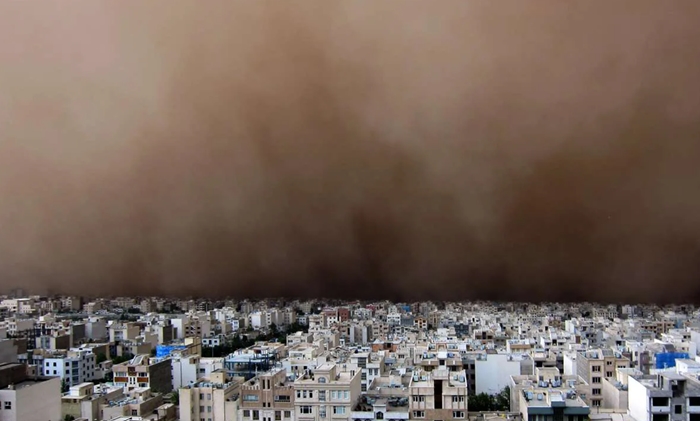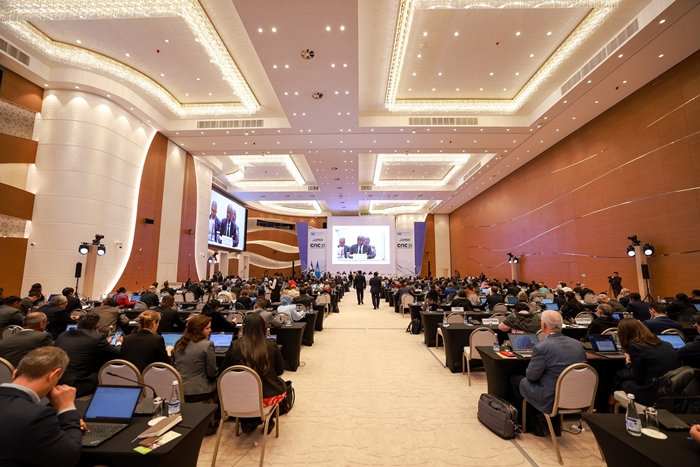The prevalence of sand and dust storms has intensified worldwide, with human activity contributing to over 25% of these occurrences, according to the UN Convention to Combat Desertification (UNCCD). Each year, an estimated 2 billion tons of sand and dust enter the atmosphere, a weight equivalent to 350 Great Pyramids of Giza.
This alarming trend was highlighted during the five-day session held in Samarkand, Uzbekistan, from 13-17 November 2023, which focused on assessing global progress in implementing the UNCCD (CRIC 21).
On the sidelines of the CRIC session, a high-level meeting convened on 15 November on ways to address the impacts of sand and dust storms on global agriculture, industry, transportation, water and air quality, and human health.
Says Ibrahim Thiaw, UNCCD’s Executive Secretary: “The sight of rolling dark clouds of sand and dust engulfing everything in their path and turning day into night is one of nature’s most intimidating spectacles. It is a costly phenomenon that wreaks havoc everywhere from Northern and Central Asia to sub-Saharan Africa.”
“Sand and dust storms present a formidable challenge to achieving sustainable development. However, just as sand and dust storms are exacerbated by human activities, they can also be reduced through human actions,” adds Thiaw.
 As the Minister of Ecology, Environment and Climate Change of Uzbekistan Aziz Abdukhakimov noted in his opening remarks, the environment ministers of the Central Asian countries have created an effective platform where pressing issues are discussed and opinions are exchanged. “I propose today to expand this platform and unite a wider range of politicians from neighboring regions,” the minister said.
As the Minister of Ecology, Environment and Climate Change of Uzbekistan Aziz Abdukhakimov noted in his opening remarks, the environment ministers of the Central Asian countries have created an effective platform where pressing issues are discussed and opinions are exchanged. “I propose today to expand this platform and unite a wider range of politicians from neighboring regions,” the minister said.
While sand and dust storms (SDS) are a regionally common and seasonal natural phenomenon, the problem is exacerbated by poor land and water management, droughts, and climate change, according to UNCCD experts.
“Sand and dust storms (SDS) have become increasingly frequent and severe having substantial transboundary impacts, affecting various aspects of the environment, climate, health, agriculture, livelihoods and the socioeconomic well-being of individuals. The accumulation of impacts from sand and dust storms can be significant,” says Feras Ziadat, Technical Officer at the Food and Agriculture Organization of the UN (FAO), Chair of the UN Coalition on Combating Sand and Dust Storms.
“In source areas, they damage crops, affect livestock, and strip topsoil. In depositional areas atmospheric dust, especially in combination with local industrial pollution, can cause or worsen human health problems such as respiratory diseases. Communications, power generation, transport, and supply chains can also be disrupted by low visibility and dust-induced mechanical failures. The United Nations Coalition on Combating Sand and Dust Storms, currently chaired by FAO, was created in 2019 to lead global efforts to tackle SDS.”
In their Sand and Dust Storms Compendium and accompanying SDS Toolbox (https://www.unccd.int/land-and-life/sand-and-dust-storms/toolbox ), UNCCD, FAO and partners offer guidance on approaches and methodologies for collecting and assessing SDS data, monitoring and early warning, impact mitigation and preparedness, and source mapping and anthropogenic source mitigation at sub-national, national, regional and global levels.
Sand and dust storms
Sand and dust storms (SDS) are known by many local names: the sirocco, haboob, yellow dust, white storms, or the harmattan.
They can also occur in other environments, including agricultural and high-latitude areas in humid regions, when specific wind and atmospheric conditions coincide. SDS events can have substantial transboundary impacts, over thousands of kilometers. Unified and coherent global and regional policy responses are needed, especially to address source mitigation, early warning systems, and monitoring.
The major global sources of mineral dust are in the northern hemisphere across North Africa, the Middle East and East Asia. In the southern hemisphere, Australia, South America and Southern Africa are the main dust sources.
The dried-up Aral Sea is a major source of SDS, emitting more than 100 million tons of dust and poisonous salts every year, impacting the health not just of the people living in the vicinity, but far beyond and generating annual losses of US$ 44 million.
The multi-faceted, cross-sectoral and transnational impacts of SDS directly affect 11 of the 17 Sustainable Development Goals yet global recognition of SDS as a hazard is generally low due in part to the complexity and seasonally cumulative impact of SDS, coupled with limited data.
Insufficient information and impact assessments hinder effective decision-making and planning to effectively address SDS sources and impacts.
UNCCD helps governments create policies to promote the scaling-up of sustainable land management practices and to find and use the latest science to develop and implement effective mitigation policies.
Working with the Regional Environmental Centre for Central Asia, UNCCD assists countries vulnerable to drought and sand and dust storms in Central Asia to develop and implement risk reduction strategies at national and regional level. UNCCD encourages countries to adopt a comprehensive risk reduction strategy with monitoring and early warning systems to improve preparedness and resilience to these environmental disasters.
Among the measures most needed are
- A multi-sectoral approach bolstered by information-sharing, short- and long-term interventions, engaging multiple stakeholders, and raising awareness of SDS.
- Land restoration, using soil and water management practices to protect soils and increase vegetative cover, which have been shown to significantly reduce the extent and vulnerability of source areas, and reduce the intensity of typical SDS events.
- Early warning and monitoring, building on up-to-date risk knowledge, and forecasting, with all stakeholders (including at-risk populations) participating to ensure that warnings are provided in a timely and targeted manner
- Impact mitigation, through preparedness to reduce vulnerability, increase resilience, and enables a timely, effective response to SDS events
///nCa, 16 November 2023 (based on the press releases of the UNCCD and the Ministry of Ecology, Environmental Protection and Climate Change of Uzbekistan)
#SDS, #sand_storms, #UNCCD, #Uzbekistan, #Central_Asia, #environment, #CRIC21

